BANCO DE TEMPO is a project by the duo Isabel Löfgren and Patricia Gouvêa started in 2011 at the Jardim do Museu da República in Rio de Janeiro, and that resulted in a homonymous exhibition at Galeria do Lago, between January and May 2012. The publication released in 2015 unites in a single body of work, a conceptual aspect (text and photo) and a lyrical and poetic side (stills from the video). They find a common ground in the performative or participatory nature of each work. From a photograph - found in the historical archive of the Museum - of former President Nilo Peçanha (resident of Palácio do Catete between 1909/10) sitting on the bench gardens with his dogs, the duo started their observation, research and documentation about motion and the possibilities of experiencing time (acceleration x lenght) by park visitors with the garden benches as the main element. [We talked to the project authors]
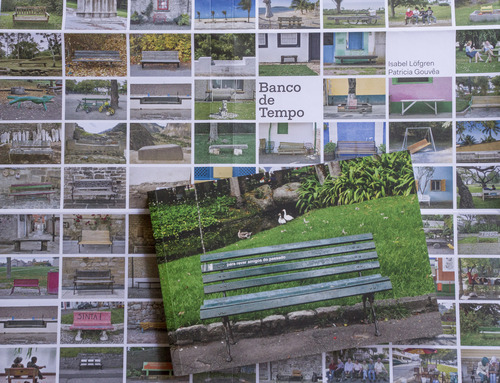
Still of the book Banco de Tempo, published in 2015
Jacques Aumont, in his book “Les Théories des Cinéastes”, talking about the Russian Andrei Tarkovsky says that the art of cinema should be the art of treating time, pick it up and re-form it - but with the greater respect for the real-time, for the alive time. It is the procedure that Tarkovsky calls "sculpting time" (title given to his book about art and cinema). Sculpting (metaphor of fine arts) and, through the editing, creating a rhythm (music metaphor). In fact, Tarkovsky’s film plans are generally long with millimetric camera movements, as if the filmmaker scanned the environment to absorb its fundamentals. In particular, this, impalpable, and omnipresent, time. How it was the work of constructing the videos for the installation ‘Sopro’? Could you define the process as “sculpting time”?
Patricia Gouvêa (PG): Very interesting that you start quoting Tarkovsky, his work is a very important reference for us. Through films, he was one of the researchers who has gone further with the study of the multiple experiences of time and on how this may affect the viewer. For example, in Andrei Rublev, 1971, we already have at the beginning of the film a long and thorough plan that follows a flying balloon over a river to shatter on the ground, a masterful camera plongée that is accelerating and then cuts another plan in slow motion of a horse gracefully rolling on the ground. This take us into his work through a sensory way.

© Still form the film 'Solaris' by Andrej Tarkovski
He was a master at it. The opening of Solaris, 1972, is also amazing, a 4 minutes plan that features a swamp, from micro to macro, with direct sound. Obviously both were millimeter planned and tested, but it always seems that there is room for the observation of the case. This ‘alive’ time so important in artistic experience, which withdraws us from the dimensions of the hours and installs a time of affection and memory.
In our three works of video installation, the starting point was our observation of two uses of time by park visitors: some use the Jardim da República as a passage between the two streets that limit (the Praia do Flamengo and the Rua do Catete), while others use it as a sort of capsule of “permanence”, using the place for experiencing “downtimes”, those that are a priori unrelated to the extraordinary of life. From this observation, we plan performative actions with the camera. We use our bodies as support to the sculpturing of time from the experience of immersion in this place.

© Banco de Tempo, installation view - Rotas de Fuga - video loop 2'30"
In each work existed an initial plan, but the chance was present to a greater or lesser extent. ‘Rotas de Fuga’ was more planned and had a more complicated implementation and editing because for us it was important to have the three channels where we walked each with a suitcase in hand and we were never in the same frame at the same time. This had to do with the fact that we are geographically separated and we find ourselves more in the virtual space than in the “real”. The suitcase for us was a metaphor of the imagined or experienced travel, of the movements we do throughout life, as well our artistic partnership carried out in a time built out of chronological time, since we live in different countries, with different time zones.

© Banco de Tempo, video still - Sopro (video 6'30") - (“Whisper”)
‘Sopro’, the last work, was the result 100% of a chance. We plan to spend the day interviewing visitors in the park when a wind storm happened there and so we were sitting on the benches with the eyes closed. There was only time to register.
In the work BANCO DE TEMPO I/DESEJO DE HORAS, memory and desire combine the reports of the meeting between you and the visitors of the park which were interviewed. Which reciprocity, for those who participate, that is, how do you feel part of an exchange? How to mobilize their imagination?
PG: Since the beginning of the project we wanted to do something where the space of the gallery interact with the park and vice versa. We searched the historical archive of the museum behind some visual history of the park, some stories that could serve as inspiration. We found the pictures of Nilo Peçanha sitting on a bench in the park with the dogs. This image matched our observation that benches in the park, which flank all the alleys, are those spaces that give the visitor a break in their day, their walk, and offers a moment of reflection, and contemplation, an opportunity for a nap and even a chat, or a dating, etc. What gives life to the park are the people and the stories that intersect on benches and their corners. What stories are these? What people think while sitting there? Where do they come from and where are they going? What does this moment of pause means in people’s lives? You touched on a key point - how to establish reciprocity with these people through a work of art, or rather, through a sensory experience.
In addition to this human and civil curiosity about the park, there was another concern, the artistic nature. Feeling limited in the practice of photography and video, we wanted to venture into other fields that were unknown to us - into the text field and the field of art in public space, and at the same time to question the notion of a copyright work.
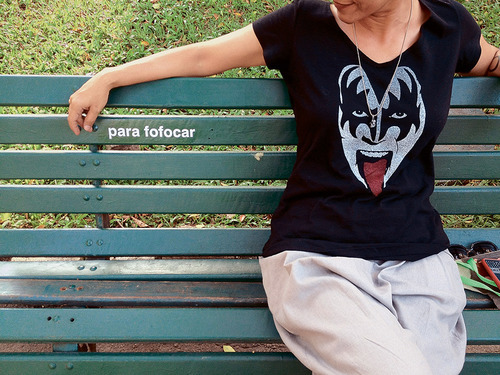
© Banco de Tempo, Installation view - Desejo de horas - text intervention on park benches
But representing the landscape is not the same thing to intervene in the landscape - and for that we had to develop another language to deal with these new parameters. From the beginning, we have already been feeding a vague idea of doing a work that required the visitor to walk into the park, and there was already a latent a desire to engage the viewer with more than just the look, but engage the body in its moving. As we realize that many people came to the park to read quietly, we had the idea to push this act of reading into something open, public. Our urban environment is polluted with words, cards, signs, advertising, text elements that require our attention all the time. In the park, as an oasis, there was no request of attention to words, but textures, colors, temperatures, environments, nature, people. How could we use a text in a noninvasive way, as if it belonged to the place? Hence arose the idea that on the back of each seat, as in a notebook agenda, we could write a sentence, a fragment of the text that will continue in the near bench and so on, creating a literary wandering through the park. But write what? Quote a text already known? Write in our own handwriting? Everything seemed to return to this copyright issue that had to be unfold. And what if the text was not written by us? And if this work was an opportunity to tell a story about this park, from the people who use this park - something that only belonged to this place?
There would be no other way to tell these stories if not by sitting on the benches and talk to people. And from these rounds have emerged incredible stories. As the whole exhibition was a meditation on time, we use this issue to motivate the conversation. In the book, we wrote a text on these meetings, these people, and everything that did not fit on the benches but was retained in our memory and in our notes. We asked to each visitors: what would you do if you had more hours in a day? In each interview, we extract the answer to this question, which has become a quotation inscribed in the bench itself - as if we were giving back to the park the stories that inhabit it already.
In the end, the result reminded a little of the structure of the book ‘Jogo de Amarelinha’ by Julio Cortazar, in which people read the text in the bench as a kind of game, a text that has no beginning, middle or end, and which presents itself as a loop. This form is reflected in our videos, which present ongoing activities and run in loops through time, allowing to watch them anywhere. Likewise, our collection of photographs also has no point of departure or arrival, neither a first nor an after, neither a cause nor a result - the images (such as the sentences) are. As in the game of hopscotch, who only plays jumps.
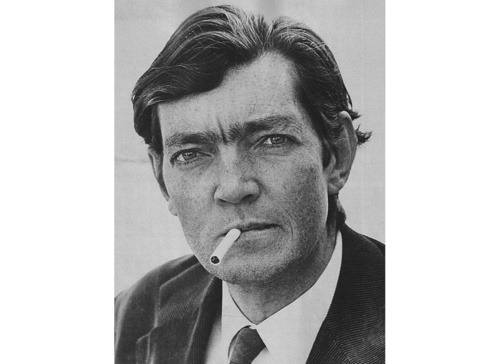
© Julio Cortázar, 1967 by Sara Facio
In the second part of this work, sentences taken from the interviews are applied on each bench of the park and their regular visitors are now invited to choose a route to find written content and fills them with meanings. Meaning that are constructed, interpreted, maintained and processed by each of them. What is the role of this second call for participation?
PG: What happened after the installation of the sentences, that is, how the texts acted, or even changed the daily life of the park is very difficult to document, it required to be present in the park, on the bench just when something happens. Every work of art in public space has this characteristic of unpredictability, and we enjoyed it - not having control over what happens next. We were fortunate to have some visitors who recorded and sent us a few moments of people interacting with the benches. These records are featured in the book as a second form of public participation, this time as registers of experience.
Also curious things happened. As the sentences were stickers on vinyl, in which each letter was an adhesive, there were those who took one or two letters of some words to change the meaning of the sentences. For example, a phrase that was originally “para o estudo” (for study) turned to “para tudo” (for all). Over time, I believe the letters were taken by people, or fell with the action of time, and the sentences were just falling apart. Today it remains very little of those sentences - and we like that too - that traces of the phrases reflect how the memory works. One day it will disappear altogether.
Speaking of side calls, the work of the benches unfolded in another work that was inside the gallery, where visitors were invited to participate, but not in an interview. Near the gallery entrance, we put an open book of dedications with the same question we have asked to park visitors as an instruction: what is your desire now? Every exhibition visitor could thus participate in this work when writing his/her 'wish for nows’ in the book. Within 5 months of exposure, the 40-page book was filled with phrases. Fun, serious, reflective, meditative, etc. This book of dedications, which we call ‘Livro de Horas’ can now be read within our publication as we scanned the pages and present them as a small delicacy.
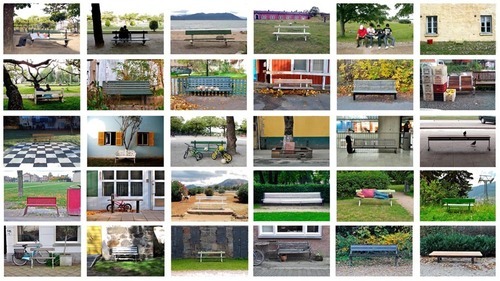
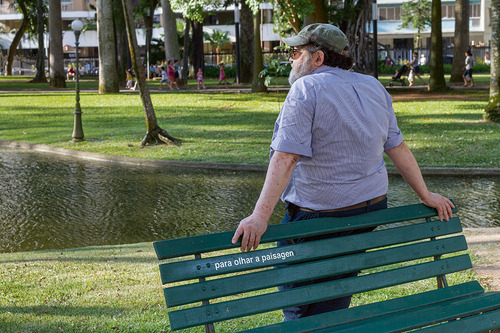
© Banco de Tempo, Installation view - Desejo de horas - text intervention on park benches
In the text ‘Ninfas’, Giorgio Agamben proposes the question: how an image can load up time? The answer, for him, is in the treatise “De la arte di ballare et Danzare,” by choreographer Domenico da Piacenza, who speaks of dance as an operation conducted on images sorted to the dancer memory. Thus, according to Domenico da Piacenza, the place of dance is not in the next move to do with the body, but in the image of the still pause that occurs between a move and another, loaded at the same time with memory and dynamic energy. In the work TIME BANK II / AROUND THE PARK IN 80 WORLDS, the images that you present seem also suspended, such as a momentary pause… As if the time that you talk about was the time of the construction of these intervals. An interval as an event between things, between places, a misfit and excessive temporality, which relies on everyday gaps. It is correct this approach?
PG: Yes, this is a beautiful way to think about the interval, and reversing the actual hierarchy of value. It’s no longer the departure and the arrival that are important, but the transitions are becoming the events. In these unfinished lapses, and intervals what matters is that they inhabit the image.

© Banco de Tempo, Installation view - Desejo de horas - text intervention on park benches
This work also deals with the repetition, as the images are all taken from the same angle. According to Deleuze, «to repeat is to behave in a certain manner, but in relation to something unique or singular which has no equal or equivalent. And perhaps this repetition at the level of external conduct echoes, for its own part, a more secret vibration which animates it, a more profound, internal repetition within the singular. This is the apparent paradox of festivals: they repeat an ‘unrepeatable’. They do not add a second and a third time to the first, but carry the first time to the ’nth’ power.» [Difference and Repetition, Gilles Deleuze]. What’s the point of repeating to you?
PG: It’s interesting that you mention Deleuze, because maybe this option of shooting all with the same angle could be a possibility of what he meant by “repetition and difference”. In the work ‘Around the park in 80 worlds’, this choice of the same angle occurred for several reasons. Firstly because it evokes the first picture, which is the photograph of Nilo Peçanha sitting in the park that we found in the museum’s file during the research phase. He had a fetish for dogs, he owned several and walked with them in the park. This picture portrays not necessarily a State figure, but a proud man of his “children” in a very casual photograph made for newspaper publication.
Each photograph we took should evoke that first image, evoking it every time, in every new bench. The idea of the collection or series, began spontaneously when we traveled together in Scandinavia in 2011, more exactly in Suomenlina island. It is a fortress built by the Swedes in Finland now used as a tourist attraction. While walking through this island for a whole day, we started talking about the project and the camera began rolling. And so we started to add points to the project as the picture of Nilo Peçanha.

© Nilo Peçanha sentado no parque com seus cães, 1911- (Photograph of former Brazilian president Nilo Peçanha found in the museum’s archive. He is shown here sitting in the same park where we did the urban intervention, with his dogs. We then photographed benches around the world in the same angle, as a re-visiting of this image. This image is in glass case inside the gallery. )
As it was a work for four hands, we also had to find a way to shoot the “same way” (or almost), so that it was difficult to distinguish the look (and click) from one another. Hence we took as principle to shoot all the benches encountered during the day-to-day, in all trips, until the time of the exhibitions, when we would have exposed one hundred of them. After the exhibition, we kept shooting benches to increase our collection. It has become part of our life, far beyond the project. It was very common during these years to send each other new benches photographed. Since then, the repetition is not only conceptual, but it was an important parameter in order to accomplish it.
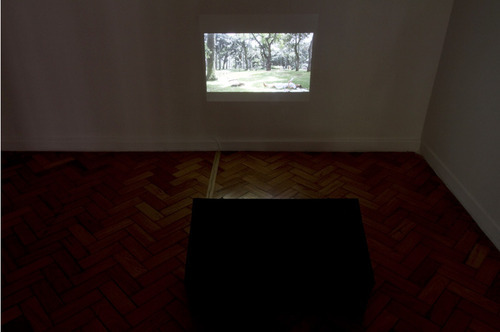
© Banco de Tempo, installation View - Lecture sur L'herbe (video 6’) - projection and suitcase
In all other video works, we work with the loop, which is a kind of repetition, towards the circular structure of the work. The interesting of these works is that we both do the same gestures alternately, sometimes mirroring each other, sometimes doing the same thing at the same time. The circular action of the films means, in our case, that the films have no beginning/middle/end as they are not telling a story or conveying a message. However, the circular films all have a turning point, a point at which the film resets or returns to an initial state, and starts all over again. Every restart, repeat this action and makes it more powerful, in our view.
---
LINKS
Isabel Löfgren
Patricia Gouvêa
Brazil
share this page